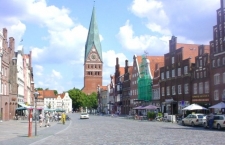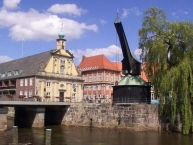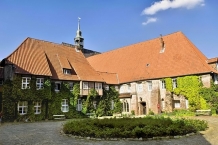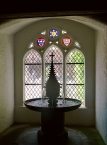Mecklenburg Lakes Cycle Route
Actions
![]()
Please wait - map data are loading
Added on 18 Aug 2012,
last edited by biroto-Redaktion on 12 Apr 2024
Actions
Cycle route metrics
Total distance in km
645
Information about rights to the gps-track data | |
|---|---|
Rights owner | OpenStreetMap and Contributors + biroto-Redaktion (biroto.eu) |
Rights characteristic / license | Contains information from OpenStreetMap, which is made available here under the Open Database License(ODbL) |
Link to the description of the license | |
GPX file taken from | |
GPX file uploaded | by biroto-Redaktion on 12 Apr 2024
|
Track points in total
7.722
Track points per km (avg)
12
Start/endpoint
Start location
Lüneburg, Niedersachsen, DE (23 m NHN)
End location
Wolgast, Mecklenburg-Vorpommern, DE (1 m NHN)
Signposting
|
Beds4Cyclists, worth visiting and infrastructure
Name and address
Latitude / Longitude
Phone
Fax
Mobile
Type of accommodation
Rating for cyclists
Route km
Dist. to route
Elevation
0 km
0,6 km
22 m
0 km
0,2 km
28 m
Information about copyright | |
|---|---|
Rights owner | |
Rights characteristic / license | by-sa: CREATIVE COMMONS Attribution-ShareAlike |
Link to the description of the license | |
Image taken over from | |
Image has been uploaded | by biroto-Redaktion on 20 Dec 2017
|
Information about copyright | |
|---|---|
Rights owner | |
Rights characteristic / license | by-sa: CREATIVE COMMONS Attribution-ShareAlike |
Link to the description of the license | |
Image taken over from | https://commons.wikimedia.org/wiki/File:Lueneburg_KranKaufhaus.jpg |
Image has been uploaded | by biroto-Redaktion on 20 Dec 2017
|
Information about copyright | |
|---|---|
Rights owner | |
Rights characteristic / license | by-sa: CREATIVE COMMONS Attribution-ShareAlike |
Link to the description of the license | |
Image taken over from | |
Image has been uploaded | by biroto-Redaktion on 20 Dec 2017
|
Information about copyright | |
|---|---|
Rights owner | |
Rights characteristic / license | by-sa: CREATIVE COMMONS Attribution-ShareAlike |
Link to the description of the license | |
Image taken over from | https://commons.wikimedia.org/wiki/File:007_-_Altstadt_(Lüneburg).jpg |
Image has been uploaded | by biroto-Redaktion on 20 Dec 2017
|
Lüneburg (also Lueneburg or Lunenburg) is an attractive and historic town on the River Ilmenau, surrounded by the Lüneburg Heath ![]() in the North German state of Lower Saxony
in the North German state of Lower Saxony ![]() . The town lies about 50 km southeast of Hamburg and is the capital of the district of Lüneburg with a population of around 73,000.
. The town lies about 50 km southeast of Hamburg and is the capital of the district of Lüneburg with a population of around 73,000.
Understand
Early history
Archaeological finds show that the area was known to Neanderthal hunters and, later, Bronze Age settlers. The town may have been that referred to as Leuphana by Ptolemy, but it was officially founded in 956.
Lüneburg was built on a salt dome which made the town important and wealthy in the Middle Ages until 1600 when it started to decline. Tradition has it that salt was first discovered by a hunter who shot and killed a wild boar bathing in a pool of water. When he hung its skin up to dry, he discovered it was full of white crystals – salt.
Lüneburg was originally overshadowed by the village of Bardowick to the north, which was a Slavic trading post. When Bardowick was destroyed by Henry the Lion in 1189, Lüneburg was granted town rights and took over the mantle as a trading centre. Its monopoly on salt production in Northern Europe quickly led to membership of the prestigious Hanseatic League – Lüneburg's salt was in great demand to preserve herring caught in the Baltic and North Seas. Initially salt was carted up the Old Salt Road to Lübeck ![]() , but was later transported by cog along river and canal. Lüneburg became very wealthy and, in 1371, threw out its princely ruler, the Duke of Brunswick-Lüneburg and destroyed his castle on the Kalkberg. In 1392 Lüneburg became a free imperial town, a status which lasted until 1637. Much of the wealth stemming from the salt trade can still be seen in the town, which boasts many buildings from Lüneburg's medieval heyday.
, but was later transported by cog along river and canal. Lüneburg became very wealthy and, in 1371, threw out its princely ruler, the Duke of Brunswick-Lüneburg and destroyed his castle on the Kalkberg. In 1392 Lüneburg became a free imperial town, a status which lasted until 1637. Much of the wealth stemming from the salt trade can still be seen in the town, which boasts many buildings from Lüneburg's medieval heyday.
Modern period
The demise of the Hanseatic League and the overfishing of herring during the 16th century led to Lüneburg's decline. New building ceased and Lüneburg survived relatively unscathed by war, which is why the town centre has largely managed to preserve its medieval character. However, the very mining that made Lüneburg wealthy and powerful has lead to ground movements that have damaged some of the old houses or lead to them being a bit crooked.
Lüneburg lost its independence in 1708, becoming part of the Electorate of Hanover, and then passed through a succession of states, before becoming part of the Prussian province of Hanover in 1866. During the 19th century it became a Prussian garrison town, but otherwise faded from the limelight.
In 1945, Lüneburg stamped its mark on history again when Field Marshal Montgomery took the German surrender on the Timeloberg hill, just south of the town. The spot is currently out-of-bounds in a military training area. Lüneburg also hosted the Belsen trial against perpetrators of the crimes at Belsen and Auschwitz concentration camps. Heinrich Himmler, infamous leader of the SS, committed suicide in Lüneburg and was subsequently buried in an unmarked location in a nearby forest.
Unlike many towns in Germany, Lüneburg was spared during the Second World War and none of its historical buildings was damaged. But its historic buildings had fallen into dangerous decay. Since the 70's the town has been gradually restored to the tourist attraction it is today.
In 1980 the saltworks finally closed ending a millennium of salt mining tradition in the town. In 1990 3 of the 4 barracks were closed and the university moved to the site of one of them.
Lüneburg today
Today, Lüneburg is thriving again as the economic and administrative centre of the region, with a strong tourist industry as the northern gateway to the Lüneburg Heath ![]() – a popular holiday and weekend destination. It also has a popular university, its 10,000 students bringing a vibrancy to the town, balancing nicely its historical setting.
– a popular holiday and weekend destination. It also has a popular university, its 10,000 students bringing a vibrancy to the town, balancing nicely its historical setting.
See
Inner Altstadt
Most of the inner Altstadt is a pedestrian area and is home to many of Lüneburg's historic sights. The main attractions here are:
- ⊙Am Sande, Am Sande. Am Sande is Lüneburg's most beautiful square and where merchants used to lay out their wares in medieval times. It is framed by a host of high ornate brick houses, a testimony to Lüneburg's wealth and status in centuries gone by and almost perfectly preserved. The oldest stepped gable on House 53 dates to around 1400. The voluted gables were generally erected in the late 16th to 17th centuries. One particular jewel is the Schütting or the "Black House" on the western side of the square with its glazed black bricks. Originally a brewery, it is now the Chamber of Industry and Commerce
- ⊙Brewery Museum (Brauereimuseum), Heiligengeiststraße 39, ☎ +49 4131 44804. Tu-Su 13:00-16:30. The Brewery Museum is housed in the old mashhouse (Sudhaus) of Lüneburg's Kronen Brewery. The museum describes the history of brewing and has a wonderful collection of beer mugs. Entry free.
- ⊙Town Hall, Am Markt 1, ☎ +49 4131 309 203. 10-17. The construction of the Rathaus, or town hall, began in 1230 and grew until 1720 when its baroque façade was constructed. The hall's Clarion contains 41 bells made of Meissner porcelain and rings several times daily. The Lüneburg Rathaus is said to be one of the most beautiful in Germany, only rivaled by Lübeck
 's city hall. Daily tours.
's city hall. Daily tours. - ⊙St. John's Church (Sankt Johanniskirche), Bei der Johanniskirche. The construction of St. John's Church started in 1289. Now a Lutheran church, it used to be Roman Catholic until the Reformation in the 16th century. While its spectacular interior justifies the visit, the church also possesses many treasures and works of art from the past, for instance a gold tabernacle from the 14th century and many precious paintings. Many concerts are offered year-wide including several short organ concerts 2 evenings a week. If you look at the tower, you will notice that it is not straight. Over time the tower has shifted 200 cm to the west!
- ⊙Fish Market (Am Stintmarkt). The fish market or Am Stint is known as the longest pub mile in Lüneburg. In the summer, the many pubs and restaurants of this area transform into large terraces and beer gardens. The fish market is also where visitors can board boats to ride on the Ilmenau river.
- ⊙Market Square (Marktplatz). Markets are held here every week of the year, including the christmas markets during Advent. In the middle of the marketplace you can see the Luna Fountain (Lunasaeule) with its figure of Diana (the goddess of hunting), a work by the sculptor, E. Bruggemann. Its name comes from the its moon ornament.
- ⊙Old Crane (Alter Kran), Am Stintmarkt. * ☎ +49 4131 2076620. The Old Crane is on Am Stintmarkt by the quayside in Lüneburg's old river port. The original crane was erected in the Middle Ages, although the current design dates to the 18th century. Its last duty was purportedly offloading the first steam engine for the Hanover and Brunswick railway.
- ⊙Lüne Mill (Lüner Mühle), Bei der Lüner Mühle. The Lüne Mill is an impressive, half-timbered, richly decorated old mill that dates to the late 16th century, but has been extensively restored.
- ⊙Bell House (Glockenhaus), Glockenhof. The Bell House and its courtyard, Bell Court (Glockenhof) make for an attractive little sideshow off Lüneburg's main square. The building was a bell foundry dating to 1482, but was also used in emergencies to cast cannon for the defence of the town.
- ⊙Hospital Zum Roten Hahn, Roterhahnstraße. The Hospital Zum Roten Hahn is a picturesque building just north of the main pedestrian area that has three attractive, half-timbered gables and a charming inner courtyard surrounding by the poorhouses from the 16th and 17th centuries. The view of St. Nicholas Church from the courtyard is a classic photo shot.
Outer Altstadt
The outer Altstadt, outside the main pedestrian precinct, also has many treasures. Chief among these are:
- ⊙German Salt Museum (Deutsches Salzmuseum), Sülfmeisterstraße 1. Apr-9 Sep 0:00-17L:00, Sa/Su 10:00-17:00 daily. The German Salt Museum is a journey through the history of salt mining and trading within the walls of the former saltworks that only closed in 1980, bringing to an end the town's centuries-old association with the industry that made its name. As well as displays and artefacts there is the opportunity for visitors to make their own salt in small pans, reminiscent of the way it was once done. €2.20.
- ⊙St. Michael's Church (Michaeliskirche), Auf dem Michaeliskloster 2b. St. Michael's Church in the Altstadt once hosted a choir for boys with outstanding treble voices who came from poor families. Its most famous student was Johann Sebastian Bach who attended St. Michael's School from 1700 to 1703 and sang soprano in the church's choir. When his voice broke around 1703, he switched to playing the harpsichord to accompany the choir. The church is worth visiting for its interesting architecture. Although some of the foundations came from an earlier abbey and date to 956, work on the rest of the foundations for the current church began in 1376 and was finished in 1379. The building itself was completed in 1412, while the tower followed in 1434 and has one of the oldest bells in Europe. Since the church was built on salt mines, over time, and due to over mining, the ground under the church dropped by 70 cm, which also tilted the structure of the church in a very interesting and strange way. Although strong steel braces now support the building, one cannot help but notice that most of its main supports and Gothic columns are very crooked. Even the orchestra section is crooked.
- ⊙Senkungsgebiet. The Senkungsgebiet is the area of Lüneburg that has suffered from subsidence as a result of mining. The salt was found below this part of the town. As it was fetched by floating the salt gallery (that was not supported sufficiently afterwards) the town sank over the years. Nowerdays it is about 5 meters lower than it was in the beginning of the salt mining. If you stand on the Marienplatz and look into the direction of the Michaelis Church, you get a good impression of this. Being the oldest part of the medieval town, there are a lot of small, beautiful houses, many of them having been carefully restored.
- ⊙Kalkberg. The Kalkberg is a limestone hill and one of the town's landmark. The limestone won from this hill was used for building houses. In Katzenstraße, there is a house with a huge buckle in the wall. This was caused by the limestone in the mortar that absorbed water from the air and hence lost its stability. Other houses collapsed due to this loss of stability, but this one remained. The hill itself is an easy climb and offers good views over the town.
In the suburbs
- Lüne Abbey (Kloster Lüne), Am Domänenhof, ☎ +49 4131 52318. Lüne Abbey is located about 2 km from the town centre There has been an abbey on the site since the 1100s, but the present day Lüne Abbey – now a convent – was founded in 1372.
Information about copyright | |
|---|---|
Rights characteristic / license | by-sa: CREATIVE COMMONS Attribution-ShareAlike |
Link to the description of the license | |
Input taken over from: |
Wikivoyage contributors, 'Lüneburg', Wikivoyage, The FREE worldwide travel guide that anyone can edit, 28 July 2017, 07:00 UTC, <https://en.wikivoyage.org/w/index.php?title=L%C3%BCneburg&oldid=3247957> [accessed 20 December 2017] |
taken over / edited on | 20 Dec 2017
|
taken over / edited by |
|
0 km
0,1 km
30 m
Hours of opening
Mai bis Oktober und im Dezember:
Montag bis Freitag: 9.30 - 18.00 Uhr
Samstag: 09.30 – 16.00 Uhr
Sonntag: 10.00 - 16.00 Uhr
Januar bis April und im November:
Montag bis Freitag: 9.30 - 18.00 Uhr
Samstag: 09.30 – 14.00 Uhr
Sonntag: geschlossen
0 km
0,9 km
30 m
2 km
0,1 km
22 m
Information about copyright | |
|---|---|
Rights owner | |
Rights characteristic / license | by-sa: CREATIVE COMMONS Attribution-ShareAlike |
Link to the description of the license | |
Image taken over from | |
Image has been uploaded | by biroto-Redaktion on 20 Dec 2017
|
Information about copyright | |
|---|---|
Rights owner | |
Rights characteristic / license | by-sa: CREATIVE COMMONS Attribution-ShareAlike |
Link to the description of the license | |
Image taken over from | https://commons.wikimedia.org/wiki/File:Lüneburg_-_Kloster_Lüne_09_ies.jpg |
Image has been uploaded | by biroto-Redaktion on 20 Dec 2017
|
Information about copyright | |
|---|---|
Rights owner | |
Rights characteristic / license | cc0: Public Domain no Rights reserved |
Link to the description of the license | |
Image taken over from | https://commons.wikimedia.org/wiki/File:Kloster_Lüne_Brunnen_1.jpg |
Image has been uploaded | by biroto-Redaktion on 20 Dec 2017
|
Information about copyright | |
|---|---|
Rights owner | |
Rights characteristic / license | cc0: Public Domain no Rights reserved |
Link to the description of the license | |
Image taken over from | https://commons.wikimedia.org/wiki/File:Kloster_Lüne_Sommerremter_1.jpg |
Image has been uploaded | by biroto-Redaktion on 20 Dec 2017
|
Lüne Abbey (German: Kloster Lüne) is an abbey in Lüneburg , in the German state of Lower Saxony, which was originally built for Benedictine nuns and today is home to a chapter of Lutheran conventuals.
History
Lüne Abbey was founded in 1172 by Hildeswidis von Markboldestorp. In the founding document by Hugo, Bishop of Verden, there is no mention of the observances to be followed, so that it is assumed that it was a chapter of canonesses. Not until 1272 was the nunnery described in a document as an abbey for Benedictine nuns and only from the mid-14th century is a full adoption of Benedictine observances recorded.
The abbey was overseen by an abbess. Its administration and pastoral care was placed in the charge of a provost elected by the nuns. One of these provosts, Henry of Langlingen (aka of Langeln, d. 1381), was elected Prince-Bishop of Verden by the Verden cathedral chapter in 1367. Lüne nunnery belonged to the Bursfelde Congregation.
Following the introduction of the Reformation in the Principality of Lüneburg the first service in the German language was celebrated on 26 April 1528 at the instigation of Duke Ernest the Confessor, despite the opposition of the nuns. In 1529 the provostship's property was placed under ducal administration and a new provost, selected by the local lords, was installed who was to ensure the implementation of Lutheran doctrine.
However, due to considerably resistance by the orthodox nuns it took until 1562 before the new doctrine was fully adopted throughout the convent. On the basis of a rule in the Lüneburg Monastic Regulations the monastery retained its independence however. In 1711, at the behest of Duke George-Louis (later George I of Great Britain) the monastery was turned into a Lutheran convent, whose primary task was to take care of unmarried daughters of Lüneburg's country gentry.
The nunnery has belonged to the Hanoverian monastic chamber since the 19th century. Currently (2008) it is in the charge of Abbess Reinhild von der Goltz.
Architecture
In 1380 the monastery was rebuilt in the Brick Gothic style after a major fire. The cloisters, the single-nave church of 1412 and the Nonnenchor are well preserved, the same is true of the former Dormitorium (dormitory).
Art
Lüne is famous for its knitting and embroidery (wool on linen). Valuable pieces (white embroidery (Weißstickerei) altar cloths, fasting cloths (Fastentücher) and carpets, the oldest dating to around 1250, are displayed in the textile museum in the grounds of the monastery opened in 1995. In the church on the altar in the Nonnenchor is a painting from the workshop of Lucas Cranach the Elder. The high altar's triptych (carved altar) was made in the early 16th century. Also worthy of mention are the wall paintings from around 1500 in the refectory of the monastery.
Information about copyright | |
|---|---|
Rights characteristic / license | by-sa: CREATIVE COMMONS Attribution-ShareAlike |
Link to the description of the license | |
Input taken over from: |
Wikipedia contributors, 'Lüne Abbey', Wikipedia, The Free Encyclopedia, 23 June 2017, 10:30 UTC, <https://en.wikipedia.org/w/index.php?title=L%C3%BCne_Abbey&oldid=787088699> [accessed 20 December 2017] |
taken over / edited on | 20 Dec 2017
|
taken over / edited by |
|
Hours of opening
Kloster-Führungen | Dienstag – Samstag | Sonn- & Feiertage |
*Klosterbesichtigung nur mit Führung. Dauer ca. 75 Min. | ||
Museum | Dienstag – Samstag | Sonn- & Feiertage |
Café im Kloster | bis 05.11.2017 | 09.11. – 17.12.2017 |
11. 01. – 25.02.2018 | 01.03. – 31.10.2018 | |
![]()









